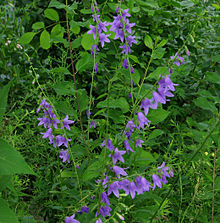- Campanula rapunculoides
-
Campanula rapunculoides 
Campanula rapunculoides, Ottawa, Ontario Scientific classification Kingdom: Plantae (unranked): Angiosperms (unranked): Eudicots (unranked): Asterids Order: Asterales Family: Campanulaceae Genus: Campanula Species: C. rapunculoides Binomial name Campanula rapunculoides
L.Synonyms - Campanula rapunculoides var. ucranica (Bess.) K. Koch
Campanula rapunculoides, common names Creeping Bellflower or Rampion Bellflower, is a perennial herbaceous plant of the genus Campanula, belonging to the family Campanulaceae.
Contents
Etymology
The genus Latin name (“campanula”), meaning small bell, refers to the bell-shape of the flower, while the specific name (“rapunculoides”) refers to the similarity to Campanula rapunculus.
Description
Campanula rapunculoides reaches on average 30–80 centimetres (12–31 in) of height, with a maximum of 120 centimetres (47 in). The stem is simple, erect and lightly pubescent and the leaves are usually shortly hairy. The basal leaves are triangular, narrow, with a heart-shaped or rounded base, jagged edges and are up to 12 centimetres (4.7 in) long. The upper stem leaves are sessile, lanceolate and shortly stalked.
The inflorescence consists of nodding spikelike racemes with numerous drooping flowers. The flowers are bright blue-violet (rarely white), 2 to 4 cm long, with short petioles standing to one side in the axils of the bracts. The bracts are quite different and smaller than the leaves. The sepals are lanceolate to ovate-lanceolate, entire, wide at the base up to 2.5 mm. The corolla is bell-shaped, with five deep lobes slightly ciliate. The flowering period extends from June through September. The flowers are pollinated by insects (bees, flies, butterflies, etc.) (entomophily). The fruit is a capsule with five pores near the base, where the seeds are spread.
This plant has its overwintering buds situated just below the soil surface (hemicryptophyte). It spreads by stolons and produces deep, taproot-shaped tubers. Because any piece of the roots can sprout into a new plant, it is extremely hard to eradicate.
Distribution
This plant is native to Europe and western Siberia and it has been introduced to North America, where it has become an invasive weed.
Habitat
It grows on grassy places, dry hills, meadows, in deciduous and pine forests, woods, fields and roadsides, along railway lines and hedgerows, preferably in partial shade, in dry to moist sites and on clay soils, relatively rich in nitrogen, at an altitude of 0–2,000 metres (0–6,600 ft) above sea level. It also occurs in cultivated fields as a weed.
Gallery
References
- Pignatti S. - Flora d'Italia – Edagricole – 1982, Vol. II, pag. 695
External links
- Biolib
- Plants.usda
- Wildflowers of Ontario
- Ontario Weeds: Creeping bellflower, Ontario Ministry of Agriculture
- Missouri Plants
- PlantFiles

This Asterales article is a stub. You can help Wikipedia by expanding it.






